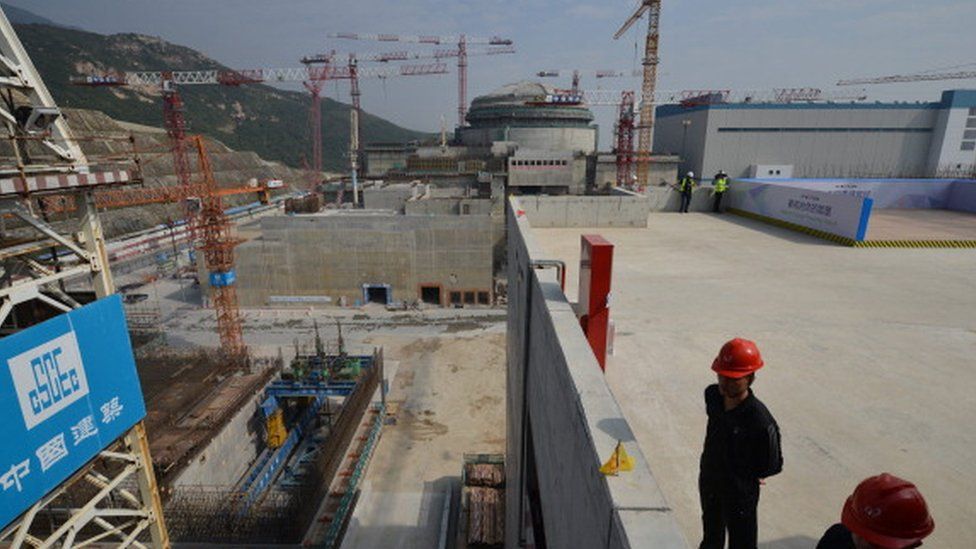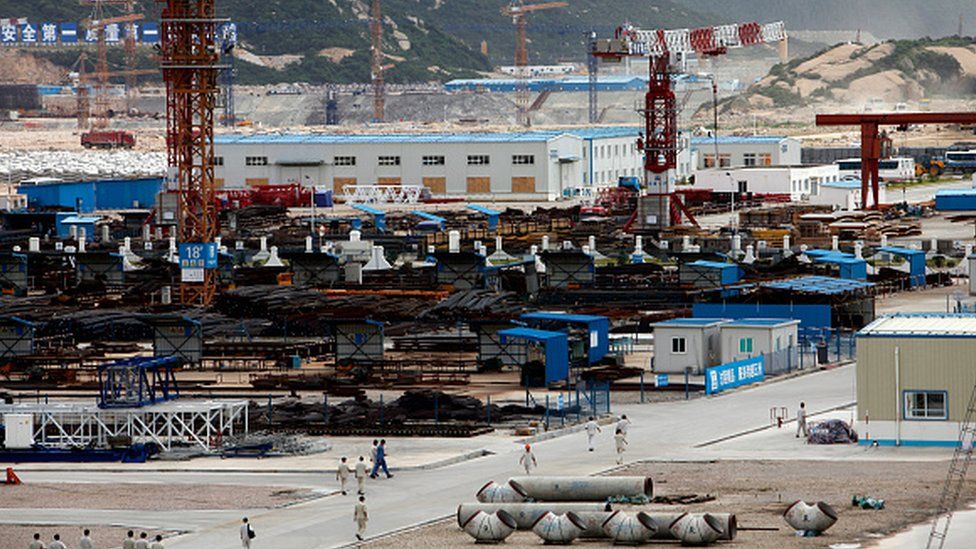June 15 2021
Taishan nuclear plant: China admits damage to fuel rods
The Chinese government has acknowledged damage to fuel rods at a nuclear power plant in the south of the country, but said no radioactivity had leaked.
China's Ministry of Ecology and Environment said the problem was "common" with no need for concern.
The admission comes after CNN reported that the US government was assessing a reported leak at the facility.
The French energy firm which helps operate the plant in Guangdong province earlier reported a "performance issue".
On Monday, a spokesperson for EDF said a problem with fuel rods had led to the build-up of gases, which had to be released into the atmosphere.
In its report, CNN said the company had warned the US government that China's nuclear regulator had raised limits on permissible levels of radiation outside the plant to avoid shutting it down.
But in a statement on Wednesday, China's environment ministry said this report was not true.
The statement - its first official confirmation of the incident - said while the regulator, the National Nuclear Safety Administration (NNSA), had reviewed the use of noble gases in a reactor, this had "nothing to do with the detection of radiation outside the nuclear plant".
Noble gases - also known as inert gases - are a group of stable chemical elements which have very low reactivity. They are often used in situations where scientists do not want chemical reactions, for instance in nuclear reactors or lighting.
An increase in radiation levels was detected in Taishan's Unit 1 reactor, but this was within the parameters for safe operations, the ministry said.
The ministry said the increase was caused by damage to the cladding of a small number of fuel rods. Fuel rods are sealed metal tubes which hold nuclear materials used to fuel the nuclear reactor.
Of the 60,000 fuel rods in the reactor, the damaged ones accounted for "less than 0.01 percent", the ministry said.
Its statement said "fuel-rod damage during the operation of nuclear power plants is unavoidable" and "a common phenomenon".
The Taishan plant provides power for the Guangzhou and Shenzhen areas, both major manufacturing hubs.
China has dozens of nuclear plants and has invested billions of dollars to develop its atomic energy sector.
China confirms broken fuel rods at nuclear plant; no radioactivity leaked

This satellite photo provided by Planet Labs Inc. shows the Taishan Nuclear Power Plant in Guangdong province, China on May 8, 2021. The Chinese nuclear power plant near Hong Kong had five broken fuel rods in a reactor but no radioactivity leaked, the government said Wednesday, June 16, 2021, in its first confirmation of the incident that prompted concern over the facility's safety.
BEIJING (AP) -- A Chinese nuclear power plant near Hong Kong had five broken fuel rods in a reactor but no radioactivity leaked, the government said Wednesday in its first confirmation of the incident that prompted concern over the facility's safety.
Radiation rose inside the No. 1 reactor of the Taishan Nuclear Power Plant in Guangdong province but was contained by barriers that functioned as planned, the Ministry of Ecology and Environment said on its social media account.
The Hong Kong government said it was watching the plant and asking officials in Guangdong for details after its French co-owner on Monday reported increased “noble gases” in the reactor. Experts said that suggested fuel rods broke and leaked radioactive gas produced during nuclear fission.
Noble gases such as xenon and krypton are byproducts of fission along with particles of cesium, strontium and other radioactive elements.
“There is no problem of radioactive leakage to the environment,” the ministry statement said. It said radiation in the reactor coolant increased but was within the “allowable range.”
The protective envelope on about five of the reactor's 60,000 fuel rods is damaged, the ministry said. It said such damage was inevitable due to manufacturing and other problems and was well below the level the facility was designed to cope with.
The ministry said regulators would oversee measures to control radiation levels within the reactor but gave no details.
The Taishan plant, which began commercial operation in December 2018, is owned by China Guangdong Nuclear Power Group and Electricite de France. A second reactor began operating in September 2019.
They are the first of a new type called European Pressurized Reactors designed by Framatome, of which Electricite de France is the majority owner. Two more are being built in Finland and France.
The ministry denied a report by CNN that regulators increased the level of radiation allowed outside the power plant to avoid shutting it down. The ministry said regulators reviewed a report about higher radiation levels in the reactor.
The International Atomic Energy Agency, a U.N. body, said Wednesday the China Atomic Energy Authority reported the reactor's “containment integrity is maintained” and “there is no environmental concern.”
China is one of the biggest users of nuclear power and is building more reactors at a time when few other governments plan new facilities because the cost of solar, wind and other alternatives is plunging.
Chinese leaders see nuclear power as a way to reduce air pollution and demand for imports of oil and gas, which they deem a security risk.
China has 50 operable reactors and is building 18 more, according to the World Nuclear Association, an industry group. China has constructed reactors based on French, U.S., Russian and Canadian technology. State-owned companies also have developed their own reactor, the Hualong One, and are marketing it abroad.
Hong Kong gets as much as one-third of its power from the Daya Bay nuclear power plant east of the territory in Guangdong. Plans call for Hong Kong to use more mainland nuclear power to allow the closure of coal-fired power plants.
Previously, the Taishan facility leaked a “small amount” of radioactive gas on April 9, the National Nuclear Safety Administration said on its website. It said the event was “Level 0,” or “without safety significance.”


No comments:
Post a Comment
Comments always welcome!